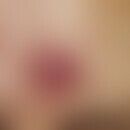DefinitionThis section has been translated automatically.
Autoinoculation by Strongyloides stercoralis (dwarf threadworm), which can be regarded as a special form of larva migrans pathognomonic for strongyloidosis. Further details see below strongyloidosis.
Occurrence/EpidemiologyThis section has been translated automatically.
The infections are mainly observed in South East Asia.
You might also be interested in
ClinicThis section has been translated automatically.
Single or multiple, band-like, elongated, recurrent, urticarial duct structures that develop within hours to days and have a particularly high migration rate (up to 10 cm/day) compared to infections with ankylostoma species (hookworms). The clinical symptoms persist for only a few hours, but recur regularly within a few months.
TherapyThis section has been translated automatically.
- Ivermectin (Mectizan) 150-200 µg/kg bw as ED, repetition of therapy after 3 weeks due to frequent reinfection is recommended.
- Alternatively: Tiabendazol (e.g. Mintezol) 2 times 25 mg/kg bw/day for 2-3 days.
- Alternatively: Albendazole (e.g. Eskazole) 400 mg/day for 3 days.
LiteratureThis section has been translated automatically.
- Bravo F et al (2003) New and re-emerging cutaneous infectious diseases in Latin America and other geographic areas. Dermatol Clin 21: 655-668
- Caumes E et al (1994) Efficacy of ivermectin in the therapy of larva currens. Arch Dermatol 130: 932
- Ly MN et al (2003) Cutaneous Strongyloides stercoralis infection: an unusual presentation. J Am Acad Dermatol 49: S157-160
Incoming links (4)
Larva migrans; Strongyloides stercoralis ; Strongyloidosis; Worm infections skin signs;Disclaimer
Please ask your physician for a reliable diagnosis. This website is only meant as a reference.




